
The Tadpole or the Egg?
What’s in the Story?
You’re in the thick forests of Indonesia and there are no villages or people around for miles. Mosquitos buzz around your face as you work your way through deep mud and dense bushes. Exhausted from the long, hot journey, you pause, but then continue on your mission. You’re searching to discover something that no one has ever seen before. Is it a treasure chest? The fountain of youth? Or the remains of an ancient civilization? Just then, you hear it right in front of you. “Ribbit, ribbit.” Believe it or not, your impressive finding is a frog.
Scientists have been studying the life cycles of frogs for a long time. The more research scientists conduct, the more we learn about the different ways that frogs develop. In the PLOS ONE article “A Novel Reproductive Mode in Frogs: A New Species of Fanged Frog with Internal Fertilization and Birth of Tadpoles,” scientists investigated a new way that frogs reproduce.
Hatching isn’t for Everyone
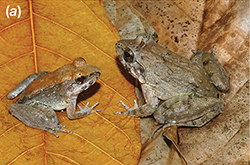
Typically, frogs lay eggs. This process usually occurs through external fertilization, where the female releases her eggs from her body into water. Then, the male releases his sperm to fertilize them.
However, a few species of frog use internal fertilization. In this case, the eggs are fertilized inside the female’s body before they are released. All mammals, including humans, use this process of fertilization.
For many years now, scientists have known about a species of fanged frog, Limnonectes larvaepartus, found in the forests of Sulawesi (an Indonesian island). However, little was known about how this species reproduced.
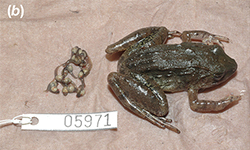
Was it through the more common process of external fertilization? Or internal fertilization? Do they lay eggs on leaves or in water, like most frog species?
In a recent expedition to Indonesia, scientists went out to explore streams and other bodies of water. They searched for these fanged frogs, and caught them with their hands. After catching a number of these frogs, they discovered something unexpected.
Instead of eggs, they found tadpoles inside the frogs. The scientists first noticed this while dissecting, or cutting into, the bodies of dead frogs. They did this to better understand the internal structure of the frogs.
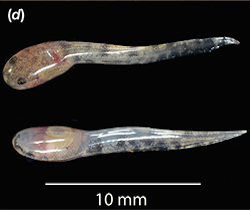
The scientists also wanted to study the body tissue and DNA from the frogs to map the frogs' genes. This would help scientists to learn the relationship between this frog species and others.
In the bodies of some female frogs, scientists found fully developed tadpoles. In one instance, a pregnant female gave birth to live tadpoles on the hand of a researcher who caught her.
These tiny tadpoles were mostly clear in color with spots around their bodies. This finding is very unusual because scientists only expected to find eggs, which are common in most female frogs.
A One of a Kind Frog
Why does this difference make the fanged frog so special? Well, there are over 6,000 known species of frogs, and this is only one that scientists know of that gives birth to live tadpoles.
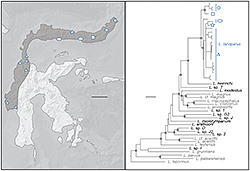
The only frogs that give birth in a similar way come from two African toad genera, Nectophrynoides and Nimbaphrynoides, and a now extinct species, Eleutherodactylus jasperi. These species give birth to miniature frogs, called froglets, rather than tadpoles. This makes the reproductive process for the fanged frog unique to any other frog that scientists currently know about.
Scientists discovered that the fanged frog uses internal fertilization. Though internal fertilization is found in other frogs, the other species either lay eggs or give birth to froglets. Discoveries like this are very exciting because it opens a whole new door of possibilities for how frogs reproduce. It also brings up questions about the larger role they have in the ecosystem because of their unique life history.
The Secret Life of Fanged Frogs
For the few frog species that use internal fertilization, the males use an intromittent organ. This is a tail-like structure located at the end of their bodies that they use to transfer sperm into the female.
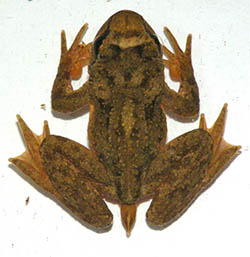
However, such an organ has not been found in male fanged frogs. This has left scientists puzzled as to how the eggs are fertilized. Unfortunately, no one has seen this fanged frog mate in the wild.
So, how do we know that these frogs use internal fertilization? Simply put, since the scientists saw the frog give birth to live tadpoles, fertilization must have occurred within the frog’s body. Fertilization would need to have occurred so that the tadpoles could develop inside the female frog’s body in the first place.
There is still much to be learned from the fanged frog, such as how females know when to give birth. But then again, there remains much more to be discovered in this strange, bizarre, and amazing world of ours.
Click here to learn more about this new species of fanged frog.
Additional Images via Wikimedia Commons. Image of 2 tadpoles by Tarquin.
Bibliographic details:
- Article: The Tadpole or the Egg?
- Author(s): Gordon Lau
- Publisher: Arizona State University School of Life Sciences Ask A Biologist
- Site name: ASU - Ask A Biologist
- Date published:
- Date accessed:
- Link: https://askabiologist.asu.edu/plosable/tadpole-or-egg
APA Style
Gordon Lau. (). The Tadpole or the Egg?. ASU - Ask A Biologist. Retrieved from https://askabiologist.asu.edu/plosable/tadpole-or-egg
Chicago Manual of Style
Gordon Lau. "The Tadpole or the Egg?". ASU - Ask A Biologist. . https://askabiologist.asu.edu/plosable/tadpole-or-egg
Gordon Lau. "The Tadpole or the Egg?". ASU - Ask A Biologist. . ASU - Ask A Biologist, Web. https://askabiologist.asu.edu/plosable/tadpole-or-egg
MLA 2017 Style

Be Part of
Ask A Biologist
By volunteering, or simply sending us feedback on the site. Scientists, teachers, writers, illustrators, and translators are all important to the program. If you are interested in helping with the website we have a Volunteers page to get the process started.
